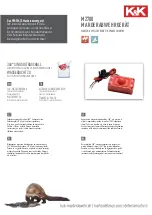
©Copyright Task Force Tips LLC 2011-2019
LIG-012 March 28, 2019 Rev06
20
5.2.3 SHAPER LOCK OUT LEVER
The G-Force has an optional shaper lock out lever that locks the shaper in a set position. Various stream patterns are possible. User
can specify with order. If not specifi ed, default position at partial fog. When locked, the lever will be on top of the nozzle. Moving a
lever unlocks the shaper for normal pattern adjustment. When rotating the shaper, the shaper will automatically become locked when
the lock out lever moves to the top of the nozzle.
UNLOCKED
LOCKED
UNLOCKED
TOP VIEW
LOCKOUT
5.2.4 STREAM PATTERN POSITION ADJUSTMENT
Typically the G-Force is factory set with the tactile indicator or lock out lever in the top position for a partial fog stream pattern. The
stream pattern can be adjusted while keeping the tactile indicator or lock out lever on top by following the steps in fi gure 5.2.4:
1)
Remove the shaper label.
2)
Loosen the clamp ring
with a pin spanner.
3)
While keeping the tactile indicator
or lock out lever on top,
rotate the shaper guide
to obtain the desired stream pattern.
4)
Tighten the clamp ring
with a pin spanner.
5)
Apply a new shaper label.
Figure 5.2.4 Stream Pattern Adjustment
5.3 FLUSH CONTROL
Small debris passes through the debris screen (if equipped) and may get caught
inside the nozzle. This trapped material will cause poor stream quality, shortened
reach, and reduced fl ow. To remove small debris, the nozzle may be fl ushed as
follows:
• While still fl owing water, rotate the index ring counterclockwise (as viewed
from behind the nozzle) to the fl ush position. (increased resistance will be felt
on the RING as the nozzle goes into fl ush) This will open the nozzle allowing
debris to pass through.
• During fl ush the nozzle reaction will decrease as the nozzle orifi ce increases
and the pressure drops. The nozzle operator must be prepared for an
increase of nozzle reaction when returning the nozzle from the fl ush position
to retain control of the nozzle.
• Rotate the selector ring out of fl ush to continue normal operations.
WARNING
Large amounts or pieces of debris may be unfl ushable and can reduce the fl ow of the nozzle
resulting in an ineff ective fl ow. In the event of a blockage, it may be necessary to retreat to a
safe area, uncouple the nozzle and remove debris.
















































